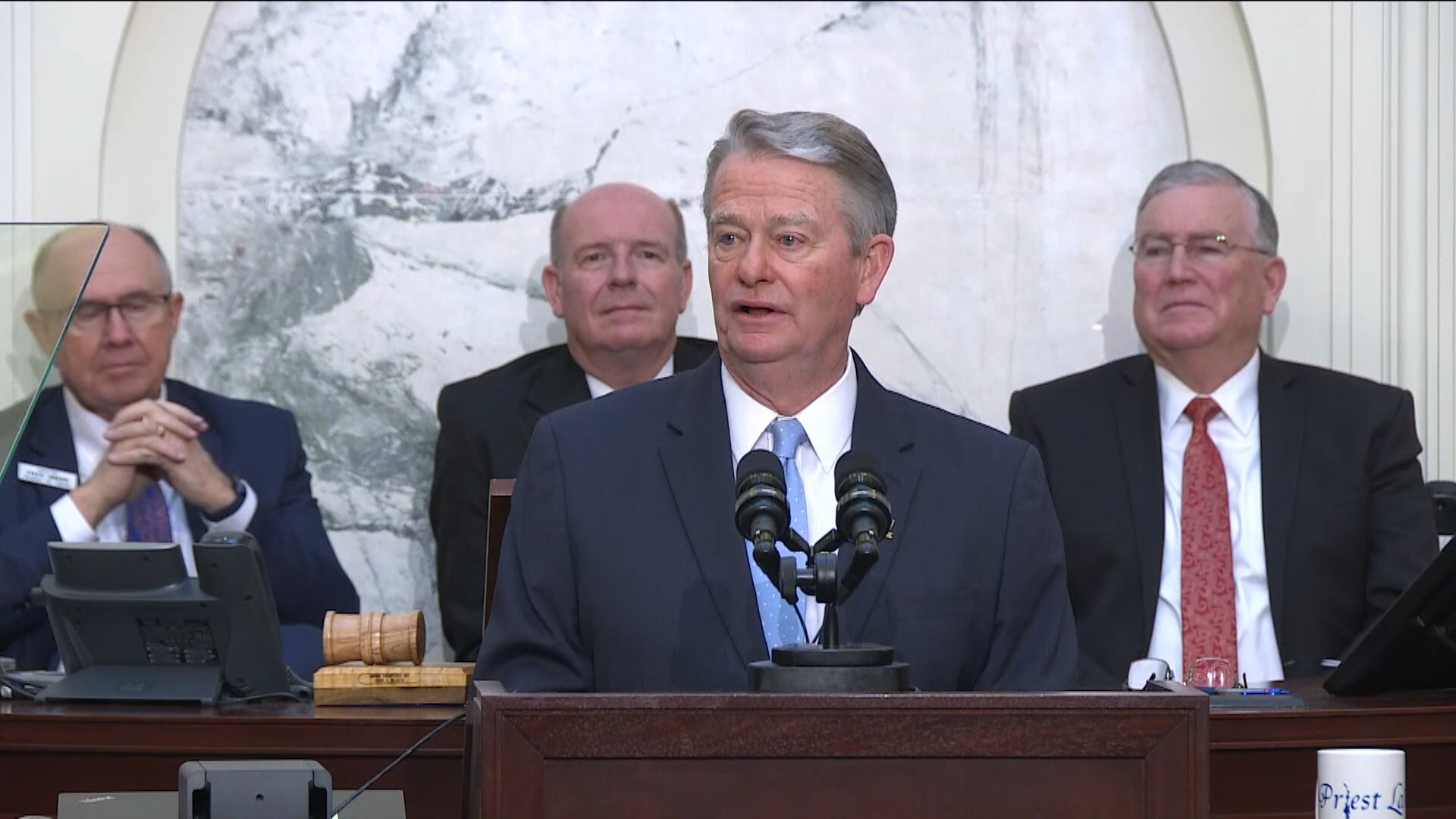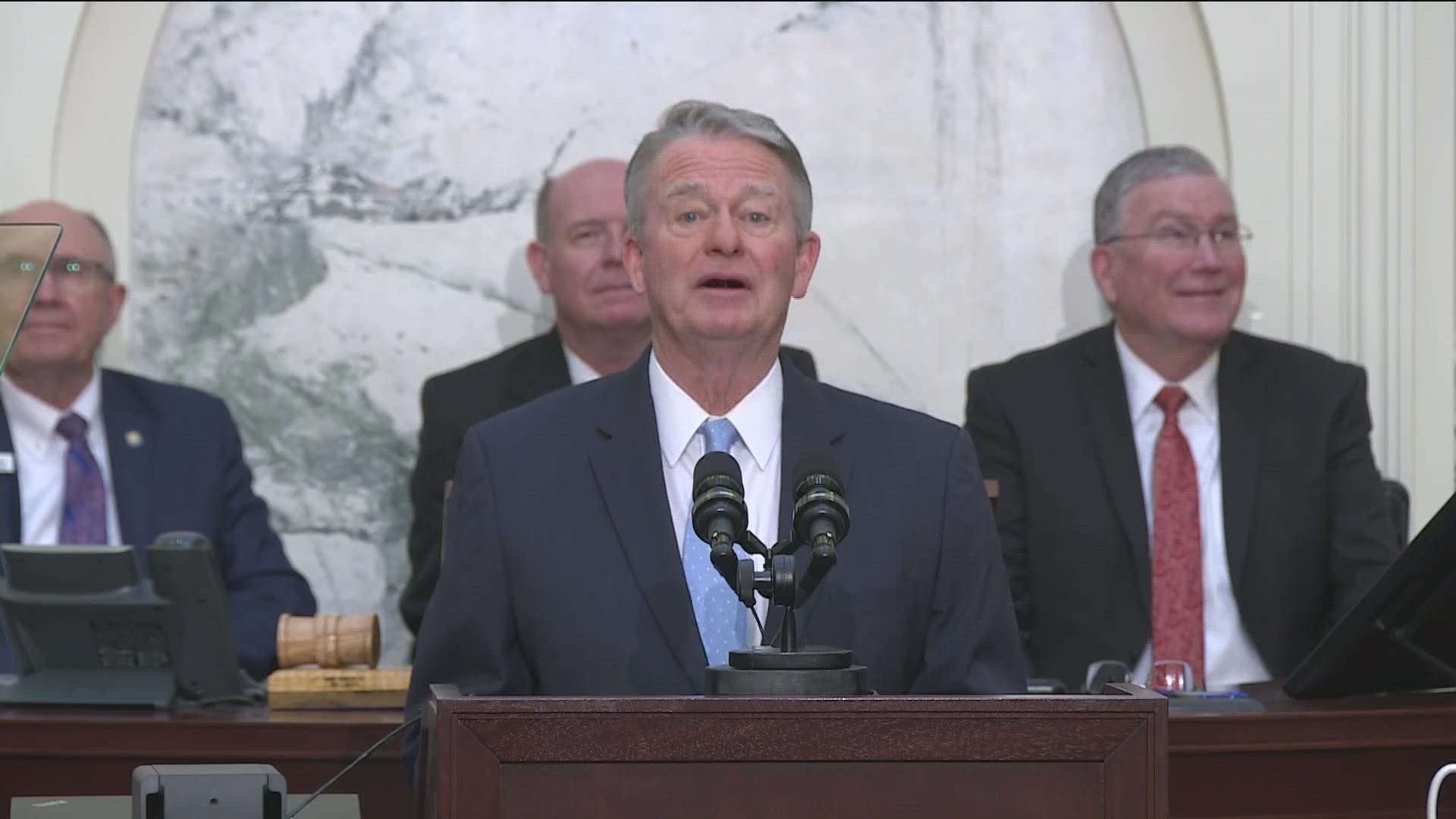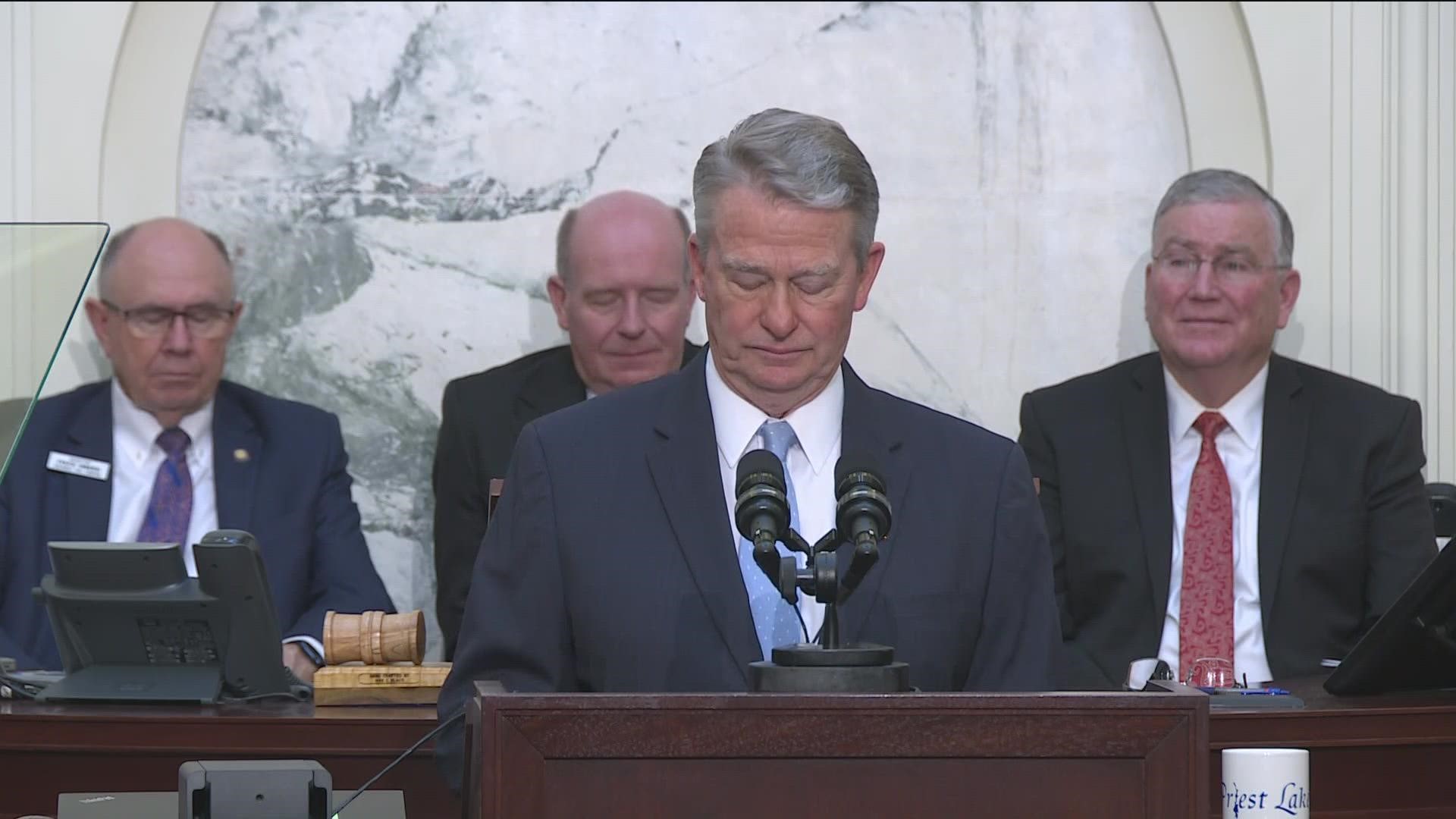Gov. Little says education is priority, remembers Idaho murder victims in 2023 State of the State Address
Gov. Brad Little is beginning his second term in office. He vowed to continue the fight against fentanyl, and proposed directing $120 million to property tax relief.

As he begins his second term as chief executive for the State of Idaho, Gov. Brad Little is urging lawmakers to “focus on the big things.”
“Let’s spend our time and energy to improve the lives of Idahoans for generations to come,” Gov. Little said Monday in the opening minutes of his 2023 State of the State Address. “With the winds at our back and a strong mandate from every corner of Idaho, let’s work together to translate the people’s vote into action by making – dare I say historic – investments in education a reality.”
The “strong mandate” the governor referred to is from the November 2022 election results: the statewide advisory vote on the legislation passed during a special session on Sept. 1, 2022. The legislation authorized one-time tax rebates late last year, established a flat income tax starting with the 2023 tax year, and established dedicated funds totaling more than $400 million for public schools and career training.
“80 percent – four out of five Idaho voters – approve of what we did during the 2022 extraordinary session last September,” he said, later adding a line that drew laughter in the Idaho House chamber. “I will sheepishly admit, I checked the ballot results in Emmett. Would you believe funding education and cutting taxes was more popular than their hometown governor?”
Idaho First plan Gov. Little talks taxes, education, crime
The State of the State Address immediately follows the opening of the new session of the Idaho Legislature. It’s an occasion for the governor to outline budget and policy recommendations.
On tax relief, Little said “we’re not done yet.” For the upcoming fiscal year, he proposes an additional $120 million toward property tax relief.
Property taxes, the governor noted, are paid to local governments – not the state government – but he said there are some things the state can do to keep property tax bills in check: state investment in local infrastructure, which could curb increases in local taxes and fees; also, looking at parameters for the circuit breaker program, which are set by the state. Circuit breaker reduces property taxes for qualified homeowners.
This year, Little is calling his package of recommendations the “Idaho First” plan. He repeated a goal he’s mentioned frequently since he first took office in 2019: “To make Idaho the place where all can have the opportunity to thrive, where our children and grandchildren choose to stay, and for the ones who have left to choose to return.”
Gov. Little said first in his Idaho First plan is education. He's proposing a new starting salary of more than $47,000 a year for new teachers, and raises averaging more than $6,300 for all teachers. The governor also proposes making the Empowering Parents grant program permanent, among other recommendations.
Little coupled his higher education proposals with expanded economic opportunities.
“We’ve made huge progress in connecting employers with resources to train employees, and my Idaho First plan helps get even more skilled workers through their doors,” he said, just before announcing his Idaho Launch proposal: scholarships of $8,500 each to graduating Idaho high school students to attend an Idaho university, college, career-technical or workforce training program.
“There are many pathways to success in today’s economy and all pathways deserve our support,” Little said. “For some students, it means getting their CDL, becoming a lineman, or pursuing welding. For others, it is engineering, teaching, healthcare or business. No matter what path a student chooses, we are making it easier for them to get the advanced training they need to propel themselves and Idaho’s economy forward.”
Another priority in his Idaho First plan, Little said, is public safety and support for law enforcement.
The governor called for a moment of silence for Ethan Chapin, Kaylee Goncalves, Xana Kernodle, and Maddie Mogen – the four University of Idaho students who were murdered in November at a house near the campus in Moscow.
“The loss of these incredible people is felt exponentially, and we will never forget them,” Little said. “We will vigorously seek justice for the victims and the many loved ones they leave behind.”
The governor's budget recommendation for Idaho State Police includes, among other things, a 10% pay raise for troopers -- about $6,000 a year, on average; also, about $200,000 to outfit every ISP officer with safety equipment, and two new staff members for the ISP sex offender registry unit.
As he talked about crime, the governor took aim at fentanyl, a powerful synthetic opioid linked to a rising number of overdose deaths. He announced proposals to fund a new ISP statewide drug interdiction team, enhanced testing and training, and a new educational awareness campaign called “All it Takes.” Little also said he is sending ISP drug interdiction specialists to the US-Mexico border, as he did in 2021 after the State of Arizona called for support.
“They will hone their skills and return with even better knowledge to train police in our state on the best ways to get fentanyl off our streets,” Gov. Little said.
State of the Budget Governor's recommendations
Over the next couple months, state lawmakers will set the budget for the 2024 fiscal year, which runs July 1, 2023, to June 30, 2024. Here’s a closer look at Gov. Little’s budget priorities, as outlined by the governor's office:
Tax relief
- Fully implement 5.8% flat income tax passed during the 2022 special session. That legislation, the governor’s office says, “returns more than $145 million in ongoing tax savings to Idahoans and eliminates taxes on the first $2,500 of income earned.
- Set aside an additional $120 million of state funding for ongoing tax relief to be directed to local government property tax mitigation.
K-12 education
- Targets starting teacher pay to Top 10 nationally ($47,477)
- Adding $145 million for enhanced teacher pay statewide – pay raises averaging more than $6,300.
- Providing $97.4 million to “close the salary gap that schools face for classified staff” and “better position schools to hire critical support staff such as cafeteria workers, bus drivers and paraprofessionals.
- Providing an additional $27.9 million for health insurance benefits for teachers and other school staff.
- $52.4 million boost in discretionary funding to schools, “allowing local schools to meet local needs and defray reliance on property taxes.”
- Providing $2.9 million in ongoing funding to improve dyslexia outcomes throughout the state through training and outreach.
- Making permanent the Empowering Parents grant program “by investing $30 million to continue helping families take charge of education expenses for their children.”
- School facility security: $20 million in one-time grants for the Securing Our Future Initiative from the Office of School Safety and Security. “Funds will be used to make meaningful, durable, and demonstrated effective investments in K-12 school facility security throughout the state.”
- $30 million in one-time grants to preserve school investments in information technology. That includes network infrastructure and student and classroom devices.
Higher education/workforce development
- $80 million to expand Idaho Launch program, providing scholarships of $8,500 for qualifying high school graduates to use at any Idaho university, community college, career technical program, or workforce training provider of their choice.
- $110 million for community college and university infrastructure “to increase capacity and prepare for rising student demand in targeted fields.”
- $15 million to train people for jobs being created through the CHIPS and Science Act of 2022. That federal legislation aims to bring semiconductor manufacturing back to the U.S.
Health and human services
- $72 million ongoing for the Idaho Behavioral Health contract that will provide $10% rate increases and expanded behavioral health services to Medicaid beneficiaries. Of the total $72 million, $21.6 million would be from the state’s general fund and $50.4 million would be federal funds.
- $24 million for construction of a secure, forensic, 26-bed mental health facility to care for patients committed and determined to be dangerously mentally ill by Idaho courts.
- Emergency medical services in rural areas: $20 million in ongoing federal funding for Ground Emergency Medical Transport to ensure viability of and access to ambulance and EMS in rural areas
- Childcare: Governor’s budget proposal provides an additional $15 million from American Rescue Plan Act (ARPA) for childcare infrastructure grants, to expand childcare capacity in partnership with Idaho employers. A portion of this recommended funding is targeted to public safety offices.
- Physician shortage: Gov. Little recommends adding $840,000 for 14 new medical residents and continue implementation of the 10-year Graduate Medical Education Plan.
- $3 million to assist independent physicians with establishing medical clinics to increase healthcare capacity and primary care access in rural Idaho.
- Veterans homes: $4 million in ongoing dedicated and federal fund spending authority to open and operate Post Falls Veterans Home; $68.4 million in federal fund spending authority to match state’s previous investment to renovate the Boise Veterans Home.
- Child abuse and neglect prevention: $2 million in “evidence-based” prevention programs; increases capacity to serve at-risk families with parenting resources and lowers the risk for families to enter the child welfare system.
Transportation and other infrastructure
“Efforts have focused on bonding for new road capacity and deferred maintenance backlog on state and local roads. The governor’s budget builds off these previous investments” and:
- Invests $96.8 million to “fully fund the known ongoing transportation safety gap.” Funding will be directed toward capacity enhancements and safety features such as turn lanes, traffic signals, widened roadways and guardrails.
- Adds $200 million to effort to improve local bridges, $35 million to improve airports throughout Idaho, and $10 million for pedestrian safety projects.
- Reserves $100 million for “economically significant local transportation projects that are otherwise beyond the reach of local government finances.”
- Broadband infrastructure: Governor’s budget leverages $225 million in federal funding to improve internet service throughout the state. “The Idaho Broadband Advisory Board will oversee the distribution of funds to ensure all corners of the state can have fast, reliable broadband.”
Public safety
- State law enforcement: 10% salary adjustment, which the governor’s office says is more than a $6,000 annual raise for an average Idaho State Police trooper. Also, providing $200,000 to outfit every state trooper with safety equipment; adding two additional staff to the ISP sex offender registry unit “to ensure thorough review of all sex offender registrants.”
- $14.8 million to build ISP facilities in Idaho Falls and Lewiston
- Fentanyl and other dangerous drugs: The governor’s budget recommendations include providing $1.6 million ongoing to ISP to develop a statewide drug interdiction team; also, $1.6 million in one-time funding and $721,000 ongoing for expansion of drug testing and fentanyl training in the Department of Correction.
- Transferring $1.1 million to the Idaho Peace Officer and Standards Training (POST) “to help stabilize against the increased costs attributable to inflation so that critical training for law enforcement officers is not further disrupted.”
- $4.1 million for additional safe teen reception centers, in addition to the eight centers funded in 2022. The centers provide an alternative placement option for troubled youth to connect them with long-term community-based resources, and “to avoid further entrance into the juvenile justice and child welfare systems.”
- $400,000 for a court implemented pre-plea diversion program and a low-risk/high-need treatment court evaluation pilot program. Those items were among those recommended by the Idaho Behavioral Health Council.
Agriculture and Natural Resources
- $150 million for state water infrastructure to maintain and expand water projects around Idaho
- $115 million to support drinking water and wastewater systems, with an emphasis on small, rural communities in need of infrastructure upgrades
- About $598,500 in ongoing dedicated and federal fund spending authority for chronic wasting disease monitoring and surveillance
- Prioritizes $15 million to strengthen the state’s energy infrastructure
- State parks: $100 million investments in outdoor recreation. “The Department of Parks and Recreation will leverage these funds to expand capacity and enhance accommodations to keep up with record attendance.” A portion of the funds will be used to propose a new funding mechanism.
- Environmental improvement programs: $12 million in grants to farmers, ranchers, dairies and confined animal feeding operations (CAFOs). The goal is to improve soil, water, and air quality in Idaho’s agricultural communities.
Rainy-day funds and planning for possible economic downturn
- “As economists across the country predict that Washington, DC, policies will cause a recession, the governor’s budget continues fiscal prudence that will better prepare Idaho for any economic conditions.
- Gov. Little recommends paying off all $37.5 million of callable debt in the GARVEE transportation bond program, “averting interest and freeing up additional transportation funding.
- State buildings: The governor recommends $300 million in one-time spending to make the second down payment on deferred maintenance, positioning the state to clear out more than half of the known deferred maintenance backlog.
- Rainy-day funds: Adding $61.7 million. “The governor’s budget will achieve the statutory maximum balances for both the Budget Stabilization Fund and Public Education Stabilization Fund.”
- Fire Suppression Deficiency Fund: Governor recommends a $68.7 million increase “to ensure the state has the resources – even in volatile economic times – to fight wildfires that threaten life, property and Idaho lands.
- Governor’s budget leaves a surplus of more than $200 million in both budgeted years to “provide a greater cushion against economic uncertainty.
- Maintains a structurally balanced budget over a five-year horizon using a fiscal stress test that accounts for the probability of a recession.
Dispatches from the statehouse KTVB reporter updates via Twitter
KTVB's Andrew Baertlein, Joe Parris and Doug Petcash were at the statehouse for the State of the State and reaction from legislative leadership:
Post-speech reaction Legislative leadership on both sides of aisle
Generally, Republican and Democratic leaders said they liked what they heard from Gov. Little.
"I really loved hearing the commitment to education and the teacher-pay piece, that real investment in our teachers. He really recognizes the complexity of what they're doing -- the hard work," said Senate Minority Leader Melissa Wintrow (D-Boise).
Senate President Pro Tem Chuck Winder (R-Boise) also said he appreciated the governor's education proposals.
Winder and Wintrow both said addressing homeowners' property tax burden will be a priority.
"I think we're going to try and deal with the circuit breaker -- get the people back on the circuit breaker that got kicked off last year; try and protect our most vulnerable, our seniors, people with the lowest incomes," Winder said. "I also think we're going to make a real conscious effort to try and use some of the sales tax revenue to offset about $120 million -- somewhere in that range -- of property tax."
House Minority Leader Ilana Rubel (D-Boise) said she was "generally very happy with the majority's proposed budget," calling it "true to the spirit" of the education funding legislation included in the bill lawmakers passed in last September's special session.
"Generally, if we came in tomorrow morning at 9 a.m. and passed this proposed budget, and then adjourned for the year, I would say it was one of the most successful sessions I've seen," Rubel said. "But of course, that's not what we'll see happen."
Republican Lt. Gov. Scott Bedke acknowledged that a lengthy "give-and-take" process may be ahead in the Legislature. Bedke was House Speaker for a decade before running successfully for the lieutenant governor's office.
"I think bringing the positive business climate and having that roll into huge investments back into education, which makes Idaho a better place to work, which makes us able to make more investments, that's kind of what excites me," Bedke said.
Idaho Republican Party Chairwoman Dorothy Moon, a former state representative from Custer County, issued a statement critical of Gov. Little's recommendations on education.
"While the governor is right to emphasize education as a pathway to economic prosperity, his embrace of teacher's union policy objectives -- including a vast increase in spending without accountability metrics -- is deeply disappointing," Moon wrote. "The governor's vision for the next four years sounded no different than the vision offered by Colorado's incumbent progressive Democrat governor... Much like the failed remote schooling policies pursued during the COVID-19 pandemic, the policies that Governor Little is advocating exist to benefit unions, not to educate students..."
Moon, who lost in the Republican primary for Secretary of State, also wrote, "Some might dismiss these concerns as an unnecessary rebuke. But our concern is not about being seen to rebuke Idaho's Republican governor but rather to stand with the people of Idaho, who have made it clear that they want policies consistent with conservative principle..."
The Republicans will once again hold supermajorities in both the Idaho House and Senate in 2023.
The legislature's website shows Republicans hold 28 seats in the Senate. The Democrats hold seven. In the House, Republicans outnumber Democrats 59 to 11.
There has also been a lot of turnover in the legislature because of redistricting and retirements. Of the 105 total members of the Idaho Legislature, 40 will be starting their first term.
Watch more Idaho politics:
See all of our latest political coverage in our YouTube playlist:
Download the KTVB mobile app to get breaking news, weather and important stories at your fingertips.



